


THE RIXFORD MFG. CO.

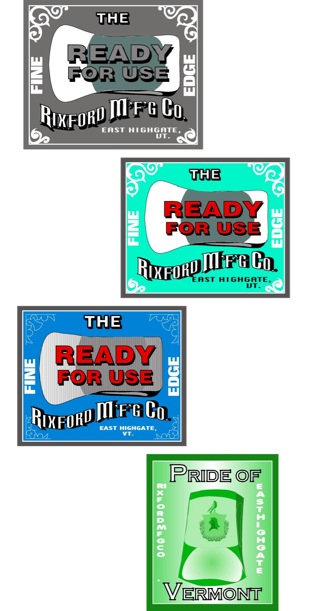


By Tom Lamond ©
EAST HIGHGATE, VERMONT
UPPER BEDFORD, QUEBEC
ST. PAUL, QUEBEC
1837-1956
1849-1895
1895-1920-1930
EARLY DEVELOPMENT
Luther Rixford originally established his business in Winchester, New Hampshire around 1812. Winchester is a community located quite close to the south-west corner of the state. Quite probably Luther was more of a blacksmith when he first went into business. Around 1837 Luther relocated to East Highgate, Vermont where he operated under the name of Luther Rixford Manufacturing Co. East Highgate is a community located approximately five miles below the US/ Canadian border near the northwest corner of Vermont.
By the mid-1840s the name Luther P. Rixford, Luther's son, became associated with the company. That suggests that Luther P. either became a principal in the company along with his father or he took over the operation of the company at that time. However, no change in the name of the company took place at that point.
By the end of the 1840s Luther P. Rixford also became involved in manufacturing in Upper Bedford, Canada. Like the East Highgate operation, Rixford in Upper Bedford originally manufactured scythes and other haying tools. Luther P. Rixford’s initial venture into manufacturing in Canada was about a half century before the Rixford Mfg. Co. (of Canada) was actually formed in Bedford by still another Rixford.
It was in the later 1840s that there was a significant growing demand for scythes on both sides of the border. Luther P. and Julian Rixford (presumedly a brother) along with a third partner named S. Page capitalized on that by acquiring the edge tool factory established by Zeno(n) Taber in 1840. (Taber was also recorded as Faber in some records.) Taber had relocated earlier from Massachusetts and established a manufactory for making scythes and axes in Upper Bedford. The factory was located on the Pike River. Indications are that Page was actually involved in some way with the factory prior to becoming involved with the Rixfords. After some intermediary reorganization and name changes, the Taber facilities became known as the Rixford Factory. The product line was initially scythes with the addition of some other haying and agricultural tools.
The company was run by the Rixfords and Page from 1849 until 1854 when the business was taken over by Joseph Higgins and R. Reed. That arrangement lasted until 1857 but it is unclear if Higgins and Reed actually owned the business or just operated it.
OSCAR S. RIXFORD MFG. CO.
In 1857 the Luther Rixford Mfg. Co. in Vermont was taken over by Oscar S. Rixford. He renamed the company the O. S. Rixford Manufacturing Co. It is understood that Oscar S. was the son of Luther P. Rixford. Around the same time, 1857, O. S. Rixford also took over the facility in Upper Bedford, which at that time was known as the Rixford Factory. Over the years the factory sustained serious damages and loses due to fires and floods. Each time it was rebuilt in the same location until sometime in the late 1880s or early 1890s. It was around then that the factory was relocated to a new site said to be in Bedford. Actually the locations were relatively close to one another and it may be that the change in location name was also effected by a community name change that eliminated the use of the word Upper.
In 1895 the Bedford Mfg. Co. was established in the same location on Spring Street, Bedford where the Rixford Mfg. Co. had been operating. The Rixford Mfg. Co. itself was relocated to St. Paul, an industrial community being developed near Montreal. Supposedly the developing industrial area in St. Paul offered more advantages in regard to securing raw materials and distributing final products.
While this was happening, O. S. Rixford maintained an interest in the Bedford Mfg. Co. in the capacity of a company director. (More info under Bedford Mfg. Co. located elsewhere on YesteryearsTools web site,)
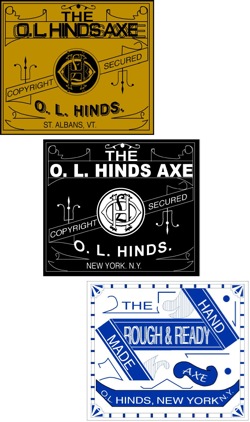
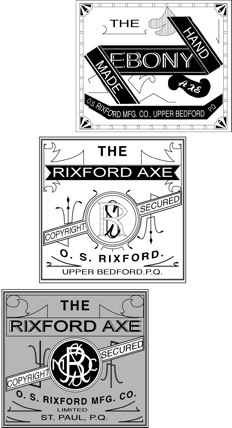
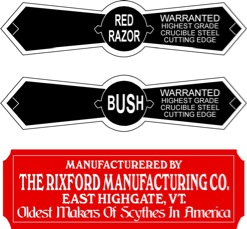
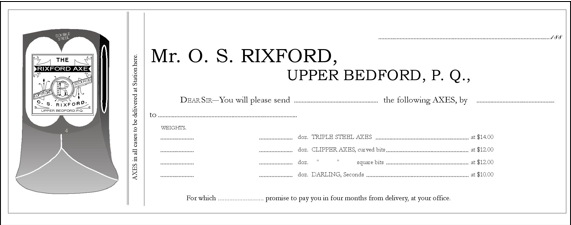
THE BEGINNINGS OF RIXFORD AXE MANUFACTURING
Interestingly, the Rixfords added axes to the production output in Upper Bedford in 1874; six years before they are known to have commenced manufacturing axes at the East Highgate location. Quite possibly the introduction of the Rixford axe line had in part something to do with the fact that prior to the Rixfords becoming involved at the Upper Bedford manufactory, Zeno Taber had manufactured axes there when he operated the factory.
As noted, O. S. Rixford was not only involved in the manufacture of edge tools, he became involved in the making of various farming tools. He also owned or invested in a number of other enterprises including a saw mill, a handle factory and a cloth factory. The cloth factory also involved Julian P. Rixford who eventually left the edge tool business and concentrated on textiles and investments.
A devastating flood eventually resulted in the factory being relocated from Upper Bedford to Bedford itself. The O. S. Rixford Manufacturing Co. continued to make scythes and axes in Bedford until 1895. It was then that the company was relocated to St. Paul, an area just north of Montreal. St. Paul was rapidly developing as an industrial community and because it was considerably closer to a big city, it was also closer to major transportation facilities. This was considered quite important at the time, as the number of major axe manufacturing competitors had increased significantly and shipping costs impacted on sales.
It is surmised that the involvement of the Rixfords in the Canadian locations was influenced by import and other regulations that impacted on American makers marketing their goods in Canada. Having a branch or a subsidiary in Canada may have provided advantages that a company with facilities only in the US may not have been afforded. A study of other axe manufacturing companies from the same era shows this to have been true for a number of axe manufacturers.
While all the activity was going on in Bedford the works at East Highgate was expanding and Rixford axes were being distributed throughout New England and other areas of the US. Quite possibly distribution also involved exporting axes to other countries. What appears to be a subsidiary company called O. L. Hinds was established. Initially that may have been the primary outlet for local distribution, as a store was opened in St. Albans, Vermont, approximately six to eight miles to the southwest of East Highgate. St. Albans was also a significant railroad depot at the time. What is believed to have been a sales office was opened in New York City under the same name, O. L. Hinds. (More info under O. L. Hinds. Co. located elsewhere on YesteryearsTools web site,)
LABELS
Labels are not known to have been used by any of the Rixford enterprises until after they began making axes. That is not to say they were not used on scythes but considering the use of labels did not really become popular until the 1870s, it is understandable why no earlier examples are known extant. Perhaps early scythes were stamped. Whether they were initially introduced on the East Highgate axes or on axes made at both general locations at the same time is also unknown. When the use of labels was adopted they were initially quite similar to two brands being represented, The Rixford Axe and The Ebony Axe. Examples of each label are known with the location of the company being the major variable.
As time went on additional labels representing more brands were used. Examples with East Highgate as the location appear to be more common but other examples marked Upper Bedford, St. Paul and Montreal are also known extant. Indications are that the use of stampings was minimal in the early years but that changed as the new century progressed. As time went on axes made in East Highgate were not only labeled but many were also stamped RIXFORD, sometimes along with a catalog number. It is not known at this point if Rixford axes made in Canada were stamped or not.
It is worthy to note that in addition to seeing labels for the Rixford companies from East Highgate, Upper Bedford, St. Paul and Montreal almost identical labels bearing the name O. L. Hinds were also used. The specifics concerning O. L. Hinds are hazy but it is known that he or a company bearing that name functioned as an agent for O. S. Rixford and that labels marked O. L. Hinds included different location names. Those locations included New York, where they had offices, East Highgate and St. Albans, Vermont. St. Albans is a community near East Highgate that at the time was a significant railroad shipping depot.
Axes bearing the labels of the O. S. Rixford Mfg. Co., Ltd. continued to be marketed until the early 1930s. The company had been acquired by Welland Vale around 1920 but distribution of the Rixford brands continued for some time. A similar changing of ownership also took place involving the Bedford Manufacturing Company sometime in the late 1920s. Axes bearing the Rixford Mfg. Co., Ltd. name were completely discontinued around 1930. Those bearing the Bedford Mfg. Co. name followed suit in 1933. Both the Rixford Mfg. Co., Ltd. and the Bedford Mfg. Co. succumbed to a similar fate. They were acquired by a major axe manufacturing company. Welland Vale acquired the Rixford Mfg. Co., Ltd. and the Bedford Mfg. Co was acquired by the Canada Axe & Harvest Tool Mfg. Co., which itself was a subsidiary of the Welland Vale Mfg. Co. The Welland Vale Mfg. Co. experienced a similar fate themselves when in 1933 they too were acquired by a larger conglomerate, the American Fork & Hoe Company operating under the name True Temper (of Canada). The Rixford Company of East Highgate, Vermont continued until 1956 when they closed their doors, not because of an acquisition but because of a significant decline in the demand for axes and an almost complete cessation of the demand for scythes.
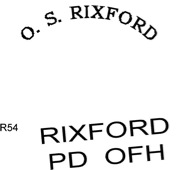
Facsimiles of scythe labels.
Stampings used on some Rixford axes. The lower example was one of the later examples.
Facsimiles of some of the later labels used by the Rixford Mfg. Co.
Facsimile examples of labels used by O. L. Hinds that looked quite similar to some used by Rixford.
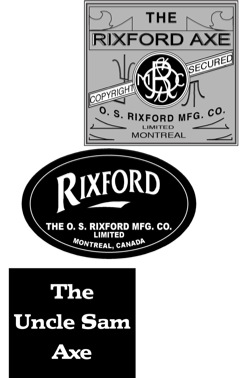
Facsimiles of Rixford labels used between 1900 and 1930 on axes made in Canada.
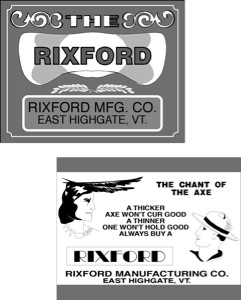
Facsimiles of labels used in the 1920s through the 1950s. The lower label was also produced with a gold colored background.
Facsimiles of labels used in the early 1900s.
Facsimiles of labels used by O. S. Rixford Mfg. Co. in the early 1900s.
Axe labels are not known to have been used by any of the Rixford enterprises until after they began making axes. Whether they were initially introduced on the East Highgate axes or on axes made at both general locations at the same time is also unknown. When the use of labels was adopted they were initially quite similar to two brands being represented, The Rixford Axe and The Ebony Axe. Examples of each label are known with the location of the company being the major variable.
As time went on additional labels representing more brands were used with East Highgate as the location but other examples from Upper Bedford or St. Paul are not known extant. Indications are that the use of stampings was minimal in the early years but that changed as the new century progressed. As time went on axes made in East Highgate were not only labeled but many were also stamped RIXFORD, sometimes along with a catalog number.
Representation of an advertising "banner" measuring 23" x 29". The original banners, or flags, were made of heavy cotton muslin and either starched or sized. Apparently there was something attached or positioned at the bottom to indicate the name of the vendor.
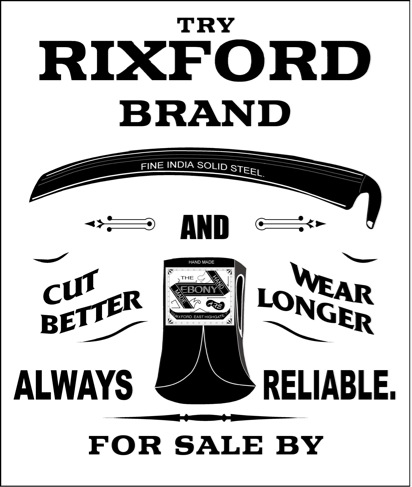
Order form used by O. S. Rixford. It is unclear how these forms were used. Perhaps they provided to accounts to expedite orders.
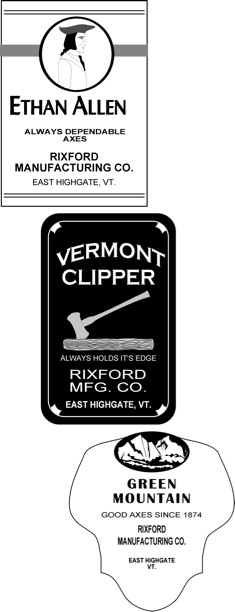


Comments, feedback and additional input are always welcome. Additional information or suggested corrections should be accompanied by verifiable sources or copies of same.
Please Contact:

Click on one of the other topics in the menu box at the top to go to a different department or article.
Facsimiles of order forms. Left: early 1880s. Right: late 1880s.


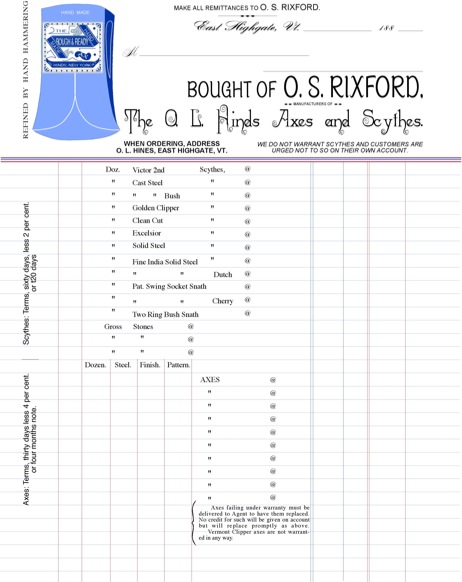
MORE INFORMATION:
Cross reference articles published on the YesteryearsTools web site that relate to this article; The Hinds Co. and Bedford Mfg. Co.
This company will be included in the NEW ENGLAND AXE MAKERS booklet.
